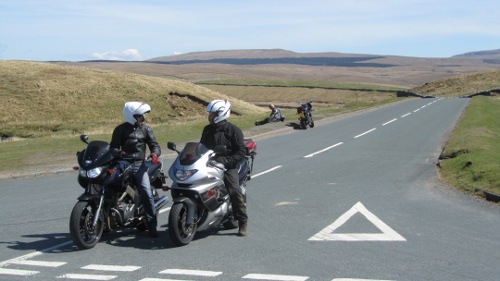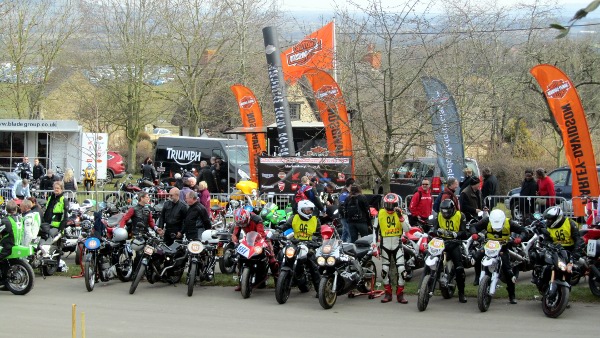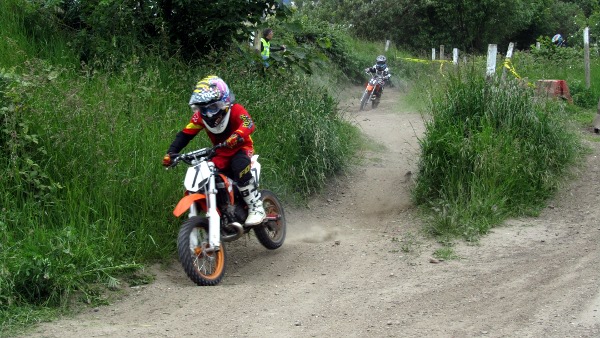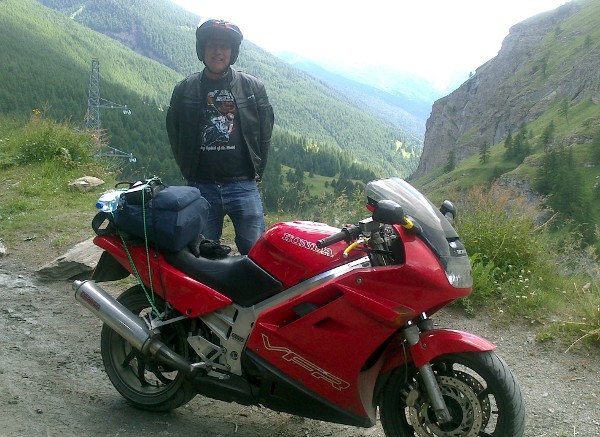Risky Business?
John Newman analyses the risks and the positives involved in motorcycling
John Newman
“You ride a motorbike? Isn't that dangerous”?
More often than not when you meet someone who doesn't know you're a motorcyclist, and they find out in the course of conversation that you are, this is the question that you will often be asked.
Depending on the mood I'm in and the circumstances, my response will either be a brief 'No', or I will reply by conceding that riding a motorcycle carries a higher level of risk than most other forms of road transport, but dangerous is not how I would classify an activity I've been involved with and enjoyed for many years.
Should the person I'm talking to not immediately dismiss me as a smart ass or curmudgeon, the conversation can lead to a positive discussion, and I can easily find myself in the role of ambassador for and corrector of, motorcycle misinformation.
The fact that people not initiated into the experience of motorcycling do not differentiate between forms of riding or machinery, means that it is difficult to deliver a succinct message about the pleasures of being involved with bikes and biking.
Despite the generic terms used to describe us, and those we use ourselves: 'motorcyclist', 'biker', 'rider', we are not a homogeneous bunch. We are differentiated by the bikes we choose to ride, the type of riding gear we wear, the other motorcyclists we are seen with and the style of riding we engage in.
In a recent article in the Guardian newspaper, one of their lead columnists, Simon Jenkins, wrote about risk in relation to thrill seeking sports: base jumping, cliff diving, mountain climbing etc. set against the stifling and stultifying approach towards any form of risk which has developed in our society. Examples abound, from the all but useless tick box risk assessments that many will be familiar with, through to overwrought discussions as to whether parents should let their children participate in certain school activities.
In one part of the article he states:
“A high risk of death or injury attends pursuits such as motorbiking, big-wave surfing, altitude climbing and, a new craze, street luging. People even go sailing off the Somalian coast to defy pirates”.
A generalisation too far!
Motorbiking! That's a generalisation too far methinks. But it does typify a certain ignorance about the whole scope of an activity that can encompass: racing on TT course and Irish roads, track racing at GP, BSB and club level; myriad off road events and activities from championship Moto X and Enduros to expert and club trials and long distance rallies and trail riding. In competitive events alone the magnitude of risk is wide, with the vast majority of those taking part not recognising or experiencing a 'high risk of death or injury'.

Similarly most who ride on the road would also reject this phrase to describe what they do. It might seem obvious to those of us involved that there is likely to be a wide 'risk gap' between the rider of a Fireblade or an R1 Yamaha, and a BMW rider to someone who chooses to get astride a cruiser type bike. Not all motorcycles and their riders are at equal risk. But it is not seen that way, and motorcycling, since its inception, has been subject to all kinds of fear and prejudice.
Historical fears and prejudices
These historical fears and prejudices have influenced most parents who are reluctant for their offspring to take up motorcycling, and at the same time have propelled politicians and bureaucrats in the UK and Europe to gradually introduce more restrictive legislation, lumbering potential riders with a complex system and a series of costly hurdles to be cleared before an unrestricted licence is granted.
Motorcycling can be risky, that's a given. But is it dangerous? Can risk be considered or measured objectively? Or is it in the very nature of risk that objective measurement is neither possible or appropriate?
Injury or death linked to racing and competitive motorcycle sport is probably perceived by the majority of people as 'fair game' in terms of personal responsibility and decision making on the part of those involved: much the same as in other high risk pursuits. In many cases those taking part may even be admired because the skill and daring they exhibit will be beyond all but a small minority in any population.
Another important aspect of motorcycle competition and other thrill seeking sports, is that they largely take place at tracks on courses, in specialist arenas, or out of sight: on mountains, at big wave beaches, on river rapids etc. Whereas the majority of everyday motorcycling activity and any accidents that happen, can be seen on public roads, and crashes can either involve a collision caused by other vehicle drivers inattention, carelessness or dangerous behaviour..
There are a lot of studies, especially from Australia, detailing the greater risk that young car drivers pose to themselves and others through inappropriate high speed driving, mobile phone use, driving with excess of alcohol and /or drugs, and succumbing to peer pressure that encourages risk when carrying passengers etc. All a bit obvious really, and much of the same will apply to younger motorcyclists: except they are far less likely to injure or kill others. Which presents a telling situation about motorcycling and risk. We might, by our actions, contrive to be a high risk to ourselves, but not necessarily to others in terms of injury or death.
Accepting that there is a risk in choosing to ride a motorcycle, how do we make the much vaunted 'informed choices' as to whether we want to ride one? There is of course the thrill of riding fast. According to psychological and genetic research carried out at the University of California, levels of Dopamine, a chemical in the brain that regulates mood and pleasure, are linked to a persons propensity to engage in (any) risk taking behaviour. Around twenty to thirty per cent of a population will inherit this genetic receptor from birth, but it's probably not an excuse that would cut it in defence of a speeding summons – 'I was born like it your honour, and I can quote academic studies to prove it'.
The open road...
People also choose motorbikes and scooters for the sheer pleasure of riding and being open to the elements, scenery, and the open road, the freedom that so many riders talk about. Then there is the convenience and cost for people who require a form of transport that will get them easily through today's clogged urban traffic. And if you're young it could simply be that you want to ride a bike or scooter that's similar to your mates.
Age is an important aspect related to risk in motorcycling and other sport where fast reactions, awareness and decision making are paramount. According to a study carried out by the University of Leeds in 2004, the average age of a motorcyclist in the UK is a shade under forty-four years. Nearly 40% of motorcyclists have more than one child living at home. Earned and disposable income is above average, and in line with other economic indicators, those in London and the south east are considerably better off.
These are sure to be factors that mitigate risk in terms of higher speed riding and thrill seeking for the majority. The more you have to lose, and the more responsibility you carry, is certain to influence the level of risk a person is prepared to engage in. There's an old joke I remember from younger motorcycling days when (in front of mates) you were more blase about crashing: “I was okay, the ground broke my fall”. But, the older the bones the greater the pain, so advancing years and a more mature attitude to actions and decisions should mean that motorcycling is and will continue to be less risky.
So how do the statistics stack up? If the tendency is for our average age to be forty plus; does this translate into fewer crashes or more? The Dept of Transport have yet to release full stats for 2012; so 2011 is the last full year we can examine. Like all statistics they open up as many questions as they answer, but the trend for those killed is thankfully on a downward trajectory.
In 2011 362 riders were killed; a 10% decrease on the previous year. However the number of serious injuries rose by 10% (5,247), and there was an overall casualty increase of 8% (20,150), which on the face of it is not such good news. Except if these figures are compared to the years 2005 -2010 they translate into an overall decrease of 33% in those killed and seriously injured, and the total miles per year covered has not changed much.
Most of us would 'defend' our chosen mode of transport and leisure, pleasure and thrill by pointing out that the failure of car drivers to look properly and pay attention is a major contributor to bike crashes; and we would be right. Almost 50% of bike crashes involving cars is the result of the driver failing to look: the ubiquitous SMIDSY – "Sorry mate I didn't see you."
A 2004 study (Clarke et al) discerned three basic types of motorcycle crash:
Right of way violation (38%)
Loss of control at bends at speed (11% +)
Overtaking/filtering (15%)
This study reiterated that most motorcycle crashes are the fault of drivers of other vehicles and recommended that road safety initiatives should be targeted at other drivers. Quite right except that the amount of resources allocated to driver and road safety awareness is paltry, and apart from those who display various 'think bike' stickers in their cars, most riders would contend that the level of understanding of the majority of drivers to motorcycle risk and vulnerability is minimal.
Hopefully the downward trend in motorcycle crashes will continue. This maybe because riders are older, perhaps slower, and more aware of the risk consequences. It is perhaps a sad but true fact that because we form a tiny minority of road users, that we do not form a very important constituency in terms of political clout. Basically we need to look out for ourselves in terms of using our experience and road craft; assertive but not aggressive riding and positioning; learning to read the 'body language' of cars and their drivers i.e. spotting a dozy or dangerous one; and if you feel you need more training, take advantage of one of the Bike Safe assessment courses and rides operated by most police forces. They might be instrumental in endorsing your licence with one hand, but they do want to see you stay alive and in one piece.
The density of traffic on public roads. The propensity for drivers to be on tight schedules, and to have more distractions in their vehicles than ever, presents the motorcyclist with more than enough hazards to contend with. But one of the advantages of this hecticity – I've made that word up – is that nearly everyone swarms towards the major routes, leaving our minor roads relatively traffic free. Explore and enjoy.
John Newman for
Wemoto News





